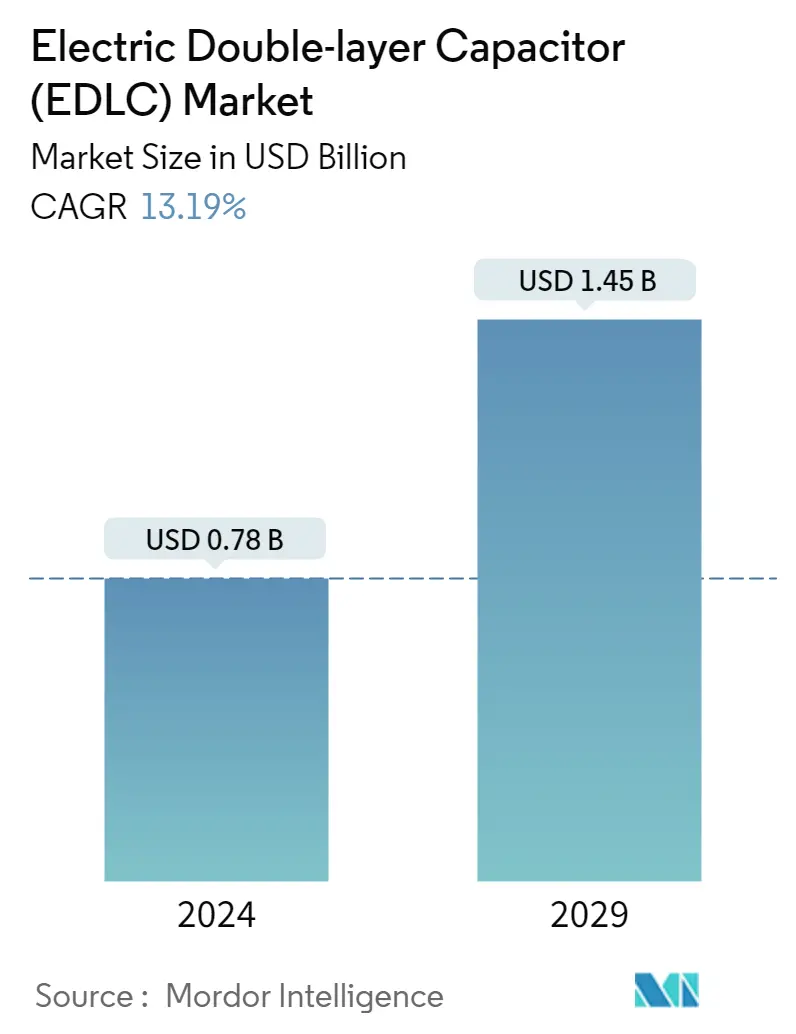Market Size of Electric Double-layer Capacitor (EDLC) Industry

| Study Period | 2019 - 2029 |
| Market Size (2024) | USD 0.78 Billion |
| Market Size (2029) | USD 1.45 Billion |
| CAGR (2024 - 2029) | 13.19 % |
| Fastest Growing Market | Asia Pacific |
| Largest Market | Europe |
Major Players_Market_Major_Players_Logo.webp)
*Disclaimer: Major Players sorted in no particular order |
Need a report that reflects how COVID-19 has impacted this market and its growth?
Electric Double-layer Capacitor Market Analysis
The Electric Double-layer Capacitor Market size is estimated at USD 0.78 billion in 2024, and is expected to reach USD 1.45 billion by 2029, growing at a CAGR of 13.19% during the forecast period (2024-2029).
The market's growth is attributed to the increased demand for electric double-layer capacitors (EDLCs) across various applications, including battery load leveling in mobile devices, memory backup in electronic devices, energy regeneration, energy harvesting in automobiles, and more. The surging demand for graphene and carbon nanotube EDLCs and government regulations regarding reducing carbon emissions are expected to contribute to the market's growth.
- EDLCs are substituting batteries in various automotive, grid, and IT applications, offering safety, faster charging, and smaller size while eliminating complicated battery management systems. Improved EDLCs and derivatives are beneficial to mini-grids, trains, trams, trucks, heavy off-road vehicles, small uninterruptible power supplies for IoT nodes using energy harvesting, and data centers. With automotive manufacturers emphasizing reducing dependency on the oil sector and governing bodies imposing stringent environmental regulations, growth prospects for electric vehicles are promising. This has led EDLC manufacturers to explore profitable opportunities in the rapidly evolving automotive industry.
- Smart meters are equipped with a power storage device to supplement their power supply for peak assistance because they need a lot of energy to transmit wireless data. However, to protect data in the case of an emergency, such as a server, power outage, or accident, or when drive recorders need an emergency backup power supply. Smart meters and drive recorders are frequently utilized outdoors, and in other low-temperature situations, power storage devices are expected to maintain their properties at low temperatures.
- Various research is underway to develop affordable and innovative solutions built on current EDLC technology. These solutions will provide a more affordable and eco-friendly alternative to existing models and stress the need to reduce the cost of carbon electrode production and the dependency on critical components.
- A major concern is the price difference between an EDLC and a regular battery. EDLCs are slightly more expensive than batteries, although they perform additional functions. This is expected to hinder the growth of the market.
- The COVID-19 outbreak and lockdown worldwide have impacted manufacturing activities, especially in Asia-Pacific, where a significant portion of the global EDLCs and electrode materials are manufactured. The surge in COVID-19 cases in Asia caused the closure of major producers of ceramic capacitor factories in China, Japan, and Malaysia. However, industries look forward to significant progress in the post-COVID-19 scenario. Some of their main priorities are advancing commercial testing of materials, progressing commercial negotiations with possible partners, and discovering new paths to market for customized EDLC applications.
